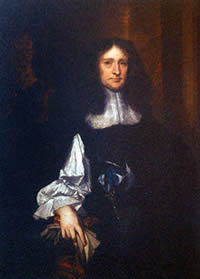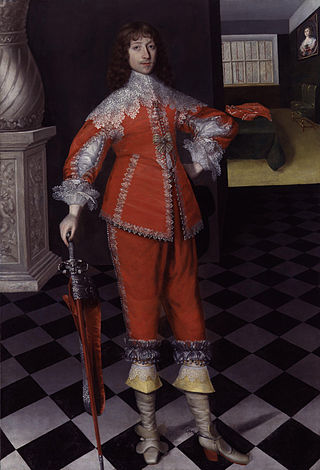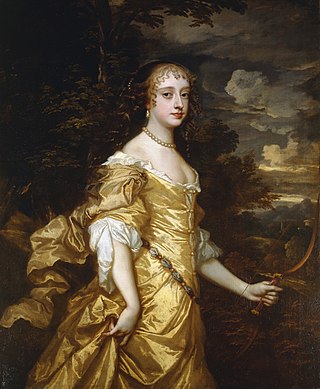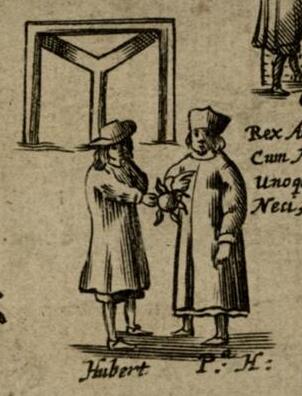Related Research Articles

Samuel Pepys was an English diarist and naval administrator. He served as administrator of the Royal Navy and Member of Parliament and is most famous for the diary he kept for a decade. Pepys had no maritime experience, but he rose to be the Chief Secretary to the Admiralty under both King Charles II and King James II through patronage, diligence, and his talent for administration. His influence and reforms at the Admiralty were important in the early professionalisation of the Royal Navy.

Charles II was King of Scotland from 1649 until 1651 and King of England, Scotland, and Ireland from the 1660 Restoration of the monarchy until his death in 1685.

Vice-Admiral Sir George Carteret, 1st Baronet was a royalist statesman in Jersey and England, who served in the Clarendon Ministry as Treasurer of the Navy. He was also one of the original lords proprietor of the former British colony of Carolina and New Jersey. Carteret, New Jersey, as well as Carteret County, North Carolina, both in the United States, are named after him. He acquired the manor of Haynes, Bedfordshire, in about 1667.

Sir Joseph Williamson, PRS was an English civil servant, diplomat and politician who sat in the House of Commons of England variously between 1665 and 1701 and in the Irish House of Commons between 1692 and 1699. He was Secretary of State for the Northern Department from 1674 to 1679.

St Olave's Church, Hart Street, is a Church of England church in the City of London, located on the corner of Hart Street and Seething Lane near Fenchurch Street railway station.

Royal Charles was an 80-gun first-rate three-decker ship of the line of the English Navy. She was built by Peter Pett and launched at Woolwich Dockyard in 1655, for the navy of the Commonwealth of England. She was originally called Naseby, named in honour of Sir Thomas Fairfax's decisive 1645 victory over the Royalist forces during the English Civil Wars. She was ordered in 1654 as one of a programme of four second rates, intended to carry 60 guns each. However, she was altered during construction to mount a complete battery of guns along the upper deck, and so was reclassed as a first rate.

Edward Montagu, 1st Earl of Sandwich, 27 July 1625 to 28 May 1672, was an English military officer, politician and diplomat from Barnwell, Northamptonshire. During the First English Civil War, he served with the Parliamentarian army, and was an MP at various times between 1645 and 1660. Under The Protectorate, he was also a member of the English Council of State and General at sea.

John Belasyse, 1st Baron Belasyse was an English nobleman, Royalist officer and Member of Parliament, notable for his role during and after the Civil War. He suffered a long spell of imprisonment during the Popish Plot, although he was never brought to trial. From 1671 until his death he lived in Whitton, near Twickenham in Middlesex. Samuel Pepys was impressed by his collection of paintings, which has long since disappeared.

Frances Teresa Stewart, Duchess of Richmond and Lennox was a prominent member of the Court of the Restoration and famous for refusing to become a mistress of Charles II of England. For her great beauty she was known as La Belle Stuart and served as the model for an idealised, female Britannia. She is one of the Windsor Beauties painted by Sir Peter Lely.
Sir Thomas Bloodworth, born Blidward, also spelt Bludworth, was an English merchant and politician who sat in the House of Commons from 1660 to 1679. He was Lord Mayor of London from October 1665 to October 1666 and his inaction during the early stages of the Great Fire of London was widely criticised as one of the causes of the great extent of the damage to the city.

Mary "Moll" Davis, also spelt Davies or Davys, was a courtesan and mistress of King Charles II of England. She was an actress and entertainer before and during her role as royal mistress.

Robert Hubert was a watchmaker from Rouen, France, who was executed following his false confession of starting the Great Fire of London.

The Great Fire of London was a major conflagration that swept through central London from Sunday 2 September to Thursday 6 September 1666, gutting the medieval City of London inside the old Roman city wall, while also extending past the wall to the west. The death toll is generally thought to have been relatively small, although some historians have challenged this belief.
Events from the year 1665 in England.

Charles II of England has been portrayed many times.
Secret Love, or The Maiden Queen is a 1667 tragicomedy written by John Dryden. The play, commonly known by its more distinctive subtitle, was acted by the King's Company at the Theatre Royal, Drury Lane. The premiere occurred on 2 March, and was a popular success. King Charles II, his brother the Duke of York and future King James II, and Samuel Pepys were all in the audience on opening night.
Sir Thomas Bond, 1st Baronet was an English landowner and Comptroller of the household of Queen Henrietta Maria.

Thomas Farriner was an English baker and churchwarden in 17th century London. Allegedly, his bakery in Pudding Lane was the source point for the Great Fire of London on 2 September 1666.

The Great Fire of London has been discussed, referenced, or recreated in popular culture numerous times.

Sir Thomas Hervey was an English Commissioner of the Royal Navy, landed gentleman, and Member of Parliament for Bury St Edmunds.
References
- ↑ "The Great Fire (2014)". Kent Film Office. 7 October 2014.
- ↑ "The Great Fire; the Knick review – One period drama takes a while to warm up, the other is deliciously gory". TheGuardian.com . 17 October 2014.
- ↑ "The Great Fire, ITV: Historical characters with fictional additions" . Independent.co.uk . 17 October 2014. Archived from the original on 18 June 2022.
- ↑ Rahim, Sameer (16 October 2014). "The Great Fire review, ITV: 'historical hokum". The Daily Telegraph. London.